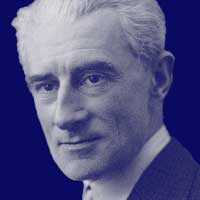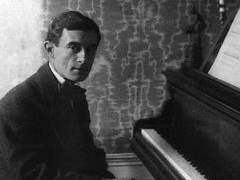Maurice Ravel - Biography
Maurice Ravel Biography
| Contents |
Biography
Ravel was born in Ciboure, France (near Biarritz, part of the French Basque region, bordering on Spain). His mother was Basque while his father was a Swiss inventor and industrialist. At seven years old, young Maurice begun piano lessons and composed pieces beginning about five or six years later. His parents encouraged his musical pursuits and sent him to the Conservatoire de Paris, first as a prepratory student and eventually as a piano major. During his schooling in Paris, Ravel joined with a number of innovative young composers who referred to themselves as the 'Apaches' because of their wild abandon. The group was well known for its drunken revelry.
He studied music at the Conservatoire under Gabriel Fauré for a remarkable fourteen years. During his years at the conservatory, Ravel tried numerous times to win the prestigious Prix de Rome, but to no avail. After a scandal involving his loss of the prize, even though he was considered the favorite to win that year, Ravel left the conservatory. The incident also lead to the resignation of the Conservatoire's director. Ravel was influenced by composer Claude Debussy; likewise, the same held true with Debussy in respect to Ravel. Ravel along with Debussy were the defining composers of the movement. Ravel was also highly influenced by music from around the world including American Jazz, Asian music, and traditional folk songs from across Europe. Ravel was not religious and was probably an atheist. He disliked the overtly religious themes of other composers, such as Richard Wagner, and instead preferred to look to classical mythology for inspiration.
Ravel never married, but he did have several long-running relationships. He was also known to frequent the bordellos of Paris.
During the First World War Ravel was not allowed to enlist because of his age and weak health and instead he became an ambulance driver.
He had very few students which included Maurice Delage and Vaughan Williams.
In 1932 Ravel was involved in an automobile accident that severely undermined his health. His output dropped dramatically. In 1937 he had an neuro-operation that he hoped would restore much of his health, but the operation was a failure and he died soon afterwards.
Musical influence
Ravel considered himself in many ways a classicist. He relied on traditional forms and structures as ways of presenting his new and innovative harmonies. He often masked the sections of his structure with transitions that would disguise the beginnings of the motif. This is apparent in his Valses nobles et sentimentales — inspired by Franz Schubert's collections, Valses nobles D 969 and Valses sentimentales D 779 — where the seven movements begin and end without pause, and in his chamber music with many movements are in sonata-allegro form, hiding the change from developmental sections to recapulation.
On the surface, he was influenced by Debussy, but also the music of Russia, Spain and the jazz music of the United States, as reflected in the movement titled Blues from his only string Trio. Ravel has almost always been considered one of the two great French musical Impressionists (the other being Debussy), but in reality he is much more than that. In his A la maniere de...Borodine (In the manner of...Borodine), Ravel plays with the ability to both mimic and remain original. In a more complex situation, A maniere de...Emmanuel Chabrier /Paraphrase sur un air de Gounod('Faust IIeme acte'), Ravel takes on a theme from Gounod's Faust (opera) and arranges it in the style of Emmanuel Chabrier. Even in writing in the style of others, Ravel's own voice as a composer remained distinct.
Ravel wrote, in 1928, that composers should be aware of both individual and national consciousness. That year, Ravel had toured the United States and Canada by train performing piano recitals in the great concert halls of twenty-five cities. In their reluctance to take jazz and blues as a nationalistic style of music, he stated America's composers' 'greatest fear is to find themselves confronted by mysterious urges to break academic rules rather than belie individual consciousness. Thereupon these musicians, good bourgeois as they are, compose their music according to the classical rules of the European epoch.' When American composer George Gershwin met Ravel, he mentioned that he would have liked to study with the French composer if that were possible. The Frenchman retorted, 'Why should you be a second-rate Ravel when you can be a first-rate Gershwin?'
His two piano concertos in many ways reflect the style of Gershwin. Of the Concerto in G, Ravel said the concertos mozart and Saint-Saens served as his model. He intended to write an earlier concerto, Zazpiak Bat, but it was never finished. The Basque title for 'Seven of One' reflects his Basque heritage, and this was a motto often used in connection with the idea of a Basque nation. Surviving notes and fragments also confirm that this naturally was to be heavily influenced by Basque music. Instead, Ravel abandoned the piece using its nationalistic themes and rhythms in some of his other pieces.
Ravel commented that it was André Gédalge, his professor of counterpoint, was very important in the development of his skill as a composer. As an orchestrator, Ravel studied the ability of each instrument carefully in order to determine the possible effects. This may account for the success of his orchestral transcriptions, both his of own piano works and those of other composers.
Ravel had very meticulously crafted manuscripts. Unfortunately, early printed editions of his works were prone to errors. Painstakingly, he would work with his publisher, Durand, in correcting them. In a letter, Ravel wrote that when proofing L'enfant et les sortilèges, after many other editors had proofread the opera, he could still find ten errors per page. Each piece was carefully crafted, although Ravel wished he could write the great quantity of works like the historical composers he admired. Igor Stravinsky once referred to Ravel as the 'Swiss Watchmaker', a reference to the intricacy and precision of Ravel's works.
Notable compositions
- Jeux d'eau (piano, 1901)
- String Quartet in F major (1903)
- Shéhérazade (ouverture de feerie) ('Scheherazade') (song cycle, 1903)
- Miroirs (Mirrors)
- Histoires naturelles ('Natural Histories') (song cycle, 1906)
- Rapsodie espagnole ('Spanish Rhapsody') (orchestra, 1907)
- L'Heure espagnole ('The Spanish Hour') (opera, 1907–1909)
- Gaspard de la nuit ('Phantom of the Night') (piano, 1908)
- Pavane pour une infante defunte ('Pavane for a Dead Princess') (piano 1899, orchestra 1910)
- Ma Mère l'Oye ('Mother Goose') (piano 1908–1910, ballet 1911)
- Daphnis et Chloé ('Daphne and Chloé') (ballet, 1909–1912)
- Valses nobles et sentimentales ('Noble and Sentimental Waltzes') (piano 1911, orchestra 1912)
- Piano Trio in a minor (1914)
- Le Tombeau de Couperin ('The Tomb of Couperin') (piano 1914–1917, orchestra 1919)
- Sonata for Violin and Cello
- Sonata for Violin and Piano in G major
- La Valse ('choreographic poem,' 1906–1914 and 1919–1920)
- L'Enfant et les sortilèges ('The Child and the Spells', 'lyric fantasy,' 1920–1925, libretto by Colette 1917)
- Tzigane (violin and piano, 1924)
- Boléro (ballet, 1928)
- Piano Concerto for the Left Hand Only in D major (1929–1930)
- Piano Concerto in G major (1929–1931)
- Don Quichotte à Dulcinée (songs, 1932–1933)
See also
External links
- http://www.maurice-ravel.net/
- Epitonic.com: Maurice Ravel (http://www.epitonic.com/artists/mauriceravel.html) featuring a track from Miroirs and Gaspard De La Nuit
- Piano Society - Ravel (http://www.pianosociety.com/index.php?id=7) - A short biography and various recordings.
- Biography of Maurice Ravel (http://www.classicalarchives.com/bios/codm/ravel_hl2.html?bool=AND&terms=Ravel%20Bolero#label_1)
- Analysis of Ravel's Trio (http://www.richard-dowling.com/RavelTrio.html)
References
- The Cambridge Companion to Ravel (Cambridge Companions to Music) Publisher: Cambridge University Press (August 24, 2000) ISBN 0521648564
This biography is published under the GNU Licence


